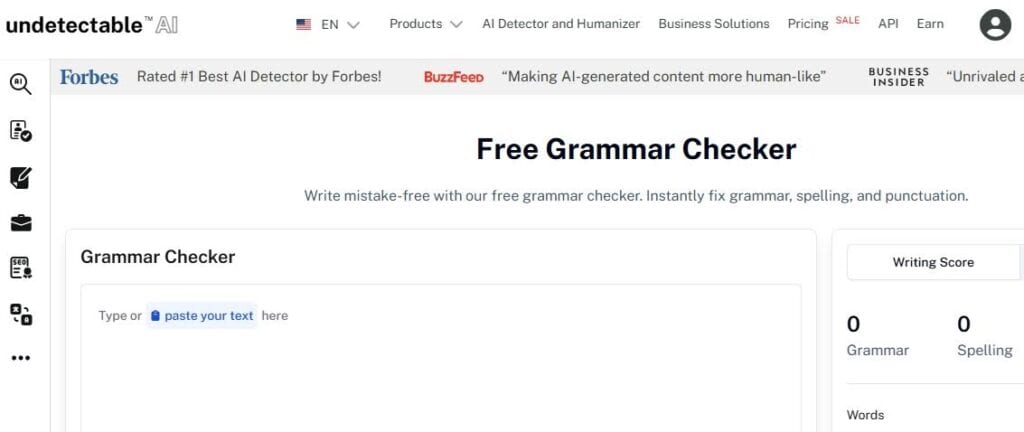I once paused an email for seven whole minutes… because I couldn’t decide between “most kind” and “kindest.”
It was a thank-you note. Nothing over the top. Just one line: “You’ve been the ______ person throughout this process.”
But suddenly, I was spiraling. Was it “kindest”? Or “most kind”? Why did both sound wrong? Why did English hate me?
A superlative adjective has a way of making your whole sentence fall apart because of just one word.
While it’s supposed to be simple, strange rules, a few exceptions, and words that break logic make it a headache.
But we’ll put a stop to this today. Let’s talk about superlative adjectives, their uses, rules, and more in this blog!
Key Takeaways
- A superlative adjective is used to show that something is the highest or lowest in a group.
- Use “-est” for short adjectives (like smallest), and “most” or “least” for longer ones (like most beautiful or least interesting).
- Comparative adjectives compare two things, while superlatives compare three or more.
- Watch out for irregular forms like best, worst, and farthest. They don’t follow the usual rules.
What Is a Superlative Adjective?

Adjectives are words we use to describe something.
A superlative adjective is used when you want to describe something that is at the top (or bottom) of a scale or a hierarchy.
Not just tall, the tallest. Not just good, the best. It’s how we show that one thing stands out from all the rest.


Never Worry About AI Detecting Your Texts Again. Undetectable AI Can Help You:
- Make your AI assisted writing appear human-like.
- Bypass all major AI detection tools with just one click.
- Use AI safely and confidently in school and work.
Superlative adjectives are used when we compare three or more things, and they answer questions like: Who is the fastest? What’s the most expensive? Which one is the least helpful?
In grammar terms, a superlative shows the highest or lowest degree of a quality.
In real life, it’s how we talk when we want to emphasize just how much something stands out, good, bad, or anywhere in between.
Superlative vs. Comparative vs. Positive Degree
You can’t fully understand what is a superlative adjective without knowing how it fits into the bigger picture.
In grammar, adjectives have three degrees of comparison, i.e., positive, comparative, and superlative.
- Positive Degree: This is the base form of the adjective. It doesn’t compare. It only describes.
(Example: tall, smart, bright.) - Comparative Degree: Used when comparing two people, places, or things. You’re showing how one measure against another.
(Words end in “-er” or include “more” or “less.”) - Superlative Degree: This form takes it up a notch. It’s used when comparing three or more things and identifying the one that stands out the most or least.
(Words end with “-est,” “most,” or “least”.)
So, in short:
- Adjective → Comparative → Superlative
(big → bigger → biggest)
(interesting → more interesting → most interesting)
Now it isn’t always this straightforward. In confusing cases, I like to use the Ask AI tool by Undetectable AI to help me differentiate between the adjective comparative and superlative forms.

How to Form Superlative Adjectives
You’ve got the definition. Now, let’s learn how to actually form superlative adjectives.
The truth is, English doesn’t always play fair. Some adjectives follow neat little rules. Others seem to do whatever they want.
But if you learn the three main patterns and the handful of irregulars, you’ll be off to a great start.
1. One-Syllable Words: Add “-est”
For short, one-syllable adjectives, forming the superlative is quite easy. You just add -est to the end of the word.
- small → smallest
- tall → tallest
- fast → fastest
These are your classic, easy examples. But watch out for spelling changes:
If the adjective ends in a single vowel followed by a single consonant (like big or hot), double the final consonant before adding “-est.”
- big → biggest
- hot → hottest
If an adjective ends in -e, just add “-st” instead of “-est.”
- large → largest
2. Multi-Syllable Words: Use “Most”
When an adjective has two or more syllables, it usually sounds clunky or downright wrong to add “-est.” That’s why you use “most” here.
- beautiful → most beautiful
- difficult → most difficult
- important → most important
This is where a lot of English learners hesitate: Should you say “beautifulest”? Nope. Not even in poetry.
There are some two-syllable adjectives that are flexible (like happy), but in general, once an adjective has more than one syllable, “most” is your safest bet.
Also, “least” is used the same way:
- least helpful
- least expensive
- least interesting
3. Irregular Forms
Ah yes, the rebels.
These adjectives break the rules completely, and there’s really no shortcut here. You just have to learn them through practice and repetition.
Some of the most common ones:
- good → better → best
- bad → worse → worst
- far → farther/further → farthest/furthest
What makes these tricky is that you can’t form them by adding “-est” or by using “most.” Saying “most good” or “baddest” might be funny, but it’s not correct in formal writing.
There are also some adjectives that technically have a regular form (fun → funnest) but are still debated. In casual conversation, “funnest” might fly. In writing? Probably safer to go with “most fun.”
Rules for Using Superlative Adjectives
Step one is knowing how to form a superlative adjective. The next step is learning how to use it correctly in a sentence.
Here are the rules you need to keep in mind:
1. Use “The” Before Superlatives (Almost Always)
Most of the time, superlative adjectives are preceded by “the” because you’re pointing to something specific, i.e., the one thing that stands out above the rest.
- She’s the smartest person in the room.
- That was the most exciting part of the movie.
“The” is an important article because you’re not just describing something, you’re identifying it as the top (or bottom) of a group.
However, sometimes in informal speech or poetry, “the” might be dropped, especially if the sentence is stylized or uses the adjective as a complement.
2. Singular vs. Plural Subjects
The superlative form stays the same, no matter if your subject is singular or plural. However, the rest of your sentence might need to be adjusted for agreement.
- This is the best solution. (singular)
- These are the best options. (plural)
3. Punctuation & Sentence Placement
Superlative adjectives can appear almost anywhere in a sentence as long as it’s clear what they’re modifying.
Here are some quick pointers:
- Before a noun:
She chose the fastest route home. - After a linking verb (like is/was/seems):
That dress is the prettiest.
He seemed the least interested. - Set off by commas (especially in descriptive phrases):
Paris, the most romantic city in the world, is worth visiting.
Punctuation-wise, don’t overthink it. Superlatives themselves don’t need special punctuation.
You just have to make sure your commas and sentence flow make the meaning clear.
Grammar rules like these can take a long time to learn.
This Grammar Checker by Undetectable AI can be super helpful.

It catches issues with article use, subject-verb agreement, and punctuation in superlative constructions, so you can write more confidently.
Examples of Superlative Adjectives
Below are a few superlative adjective examples, grouped by type, so you can get a feel for how they work in everyday language.
One-Syllable Adjectives
- small → the smallest
- fast → the fastest
- tall → the tallest
- cold → the coldest
- young → the youngest
Two or More Syllables
- beautiful → the most beautiful
- important → the most important
- confusing → the most confusing
- reliable → the most reliable
- creative → the least creative
Irregular Adjectives
- good → the best
- bad → the worst
- far → the farthest / the furthest
- little → the least
- many → the most
Superlative Adjective vs. Comparative Adjective
Should I use better or best?
Is it most effective or more effective?
Figuring out whether to use a comparative or superlative adjective is one of those small but frustrating grammar moments that can slow you down, even if you’re generally great with words.
Let’s clear up this confusion:
The Key Difference
The main difference is how many things you’re comparing.
Comparative adjectives are used when comparing two things. You’re showing how one is more or less of something than the other.
Superlative adjectives are used when comparing three or more things. You’re picking out the one that stands at the top (or bottom) of the group.
Side-by-Side Examples
Say you’re talking about restaurants:
- “This place is cheaper than the Italian one down the street.”
Here, you’re comparing two places. That’s comparative.
- “This is the cheapest restaurant in the entire neighborhood.”
Now you’re comparing it to many. That’s superlative.
When to Use Each in Context
Ask yourself: Am I comparing two things? If so, use a comparative adjective. But if you are choosing one thing that stands out from three or more, a superlative adjective is the right choice.
Remember:
- Two candidates? Choose the stronger one.
- Ten applicants? Hire the strongest one.
Common Mistakes and How to Fix Them

Even confident English speakers mess up superlatives sometimes.
Why? Because English is full of weird exceptions, and some forms just sound right, but they are not.
Let’s walk through the most common mistakes people make with superlative adjectives (and how to fix them).
1. Using the Superlative When Comparing Two Things
It’s tempting to say “the best of the two,” but grammatically, it’s not correct.
- Wrong: Between the two students, she’s the smartest.
- Right: Between the two students, she’s the smarter one.
2. Mixing Up Irregular Forms
English loves to break its own rules, and irregular adjectives are a prime example.
- Wrong: She is more good at math than he is.
- Right: She is better at math than he is.
Also:
- Wrong: This is the baddest idea ever.
- Right: This is the worst idea ever.
3. Using Both “Most” and “-est” Together
This one’s more common than you’d think, especially in casual speech or writing.
- Wrong: She’s the most prettiest girl in school.
- Right: She’s the prettiest girl in school.
(Or: She’s the most pretty girl in school—but that’s less natural.)
Use either “most” or “-est”, never both. If the word ends in “-est,” don’t add “most” in front of it.
4. Applying Superlatives to the Wrong Group
Sometimes people use a superlative adjective but don’t clearly define the group being compared. This makes the sentence vague.
- Unclear: This is the best option.
(Compared to what?) - Clear: This is the best option out of all three we discussed.
Bonus Tip: If you can’t get a sentence to sound right, try rephrasing it using Undetectable AI’s AI Humanizer.
It will rewrite any awkward superlative phrasing in your sentences and make them sound more natural.

Built for writers, students, and businesses—explore our reliable detection and humanization tools.
Final Thoughts
A superlative adjective is as much about clarity and precision as it is about grammar. It helps us express what stands out, what matters most, and what sets something apart from the rest.
Now that you have a better understanding of how they work and where they often go wrong, you’re in a stronger position to use them confidently and correctly.
If you come across a unique problem or have any questions related to it, you can use Ask AI tool to get help.
Need a second set of eyes?
Let Undetectable AI fine-tune your writing so your superlatives sound natural, polished, and unmistakably human.
